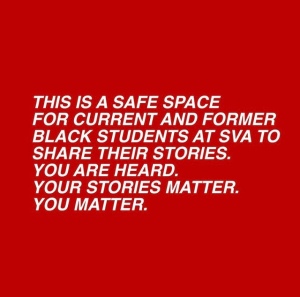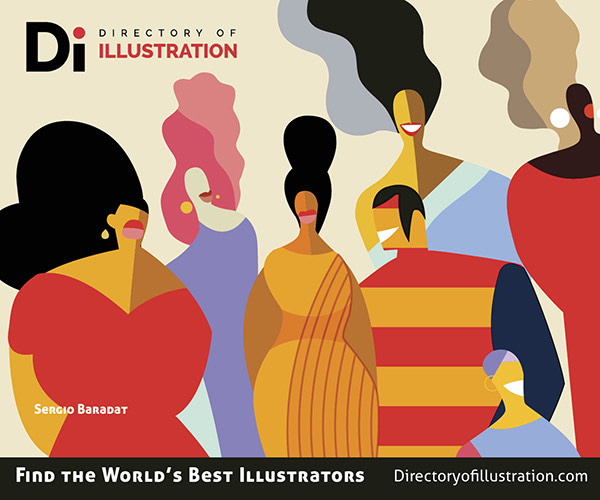 Illustration by Daniel Fishel
Illustration by Daniel Fishel
On June 28th, 2020 a new Instagram account called @blackatsva published its first post with a simple message: “This is a safe space for current and former black students at SVA to share their stories. You are heard. Your stories matter. You matter.” Accompanying the post was an open call for black students of the School of Visual Arts in New York to submit anonymous stories of their time at the college.

Since that day BlackAtSVA has published a steady stream of posts amplifying the voices of black SVA students, each one offering a troubling view of the struggles faced at the hands of faculty, staff and fellow students. As one reads through the anonymous stories it is hard to miss the common theme, which is that racism is real at SVA and that the voices of black students have long been ignored.
It’s important to note that the School of Visual Arts isn’t alone in this. The BlackAtSVA account was actually inspired by similar social media accounts currently being run by students at popular schools like the Rhode Island School of Design (@blackatRISD) and the ArtCenter College of Design (@blackataccd).
I was alerted to the existence of BlackAtSVA by a post about well-known Illustrator Chris Buzelli that garnered a ton of attention online, in which an anonymous student claimed that he treated them in a demeaning and racist way. After reading more of the posts I was immensely disappointed, but also inspired by the bravery of the students sharing their stories with the public. I soon reached out to the creator of BlackAtSVA to learn more about the project and what he/she hoped would be accomplished moving forward.
. . . . .
Illustration Age (IA): Please start by telling us what the BlackAtSVA project is all about and what inspired you to launch it.
BlackatSVA (BAS): BlackAtSVA is a platform for black students, alum, and faculty to share their stories about how racism has impacted their experience at SVA. My younger sibling’s highschool actually started a @blackat___ account and when I did more research I found a plethora of similar accounts. I noticed there wasn’t one for SVA and I thought it was important to create a safe space for students to share their experiences.
IA: What did you hope to accomplish? Was it more about giving black artists a place to share stories with each other, creating change in art education, or both?
BAS: I knew that I didn’t want it to stop at sharing stories. There needed to be institutional change. I’ve never fought back against an institution in this capacity so I didn’t know where to begin. I did some research and found documents from the 60’s from black students listing demands they needed from their college. It was insane because a lot of the demands black students fought for decades ago are still not being met.
IA: What has been the response from fellow SVA students and artists or people outside of this circle?
BAS: We have received so much support from SVA students, alum, family, friends – even people who attend other schools.
IA: Have you received any communication or acknowledgement from faculty or staff at SVA?
BAS: Some SVA faculty have privately voiced their support and acknowledgement. However SVA has failed to address the concerns black students have shared on our platform. They sent out a mass email basically saying “Ok we see that you are talking about us and our faculty, we are working on fixing it (aka working on saving their reputation), but we need students to come out publicly to move forward”. Which personally feels like a slap in the face and feels like they are still invalidating our stories. Black students are traumatized, how can you expect us to come out publicly when SVA has been covering up and protecting their white faculty for years. SVA has lacked a safe space for black students to voice their concerns on campus grounds. If we felt safe and protected this page wouldn’t have been created.
I did some research and found documents from the 60’s from black students listing demands they needed from their college. It was insane because a lot of the demands black students fought for decades ago are still not being met.
IA: From my own experience I know that there can sometimes be blowback when speaking out about injustices in the illustration industry. Have you experienced any negativity as a result of starting BlackAtSVA?
BAS: We have received legal threats, death threats, and racial gaslighting comments but I really just look the other way. That isn’t what this platform is about, I will continue to amplify stories in my community. At the end of the day we just want to be treated like human beings and like we exist. I’m not afraid nor will I back down – there is so much work to be done in all areas and it’s so important to keep fighting.
The account raked in thousands of followers because of one story mentioning Chris Buzelli – a professor at SVA. I personally don’t want to center BlackAtSVA around this incident but it is the reason why the account has gained so much attention. We must focus on the black students that have faced blatant racism, how SVA will create a safe environment for current and incoming students, and how SVA will hold their faculty accountable for their actions.
IA: You recently started the BlackAtSVA Aid Fund as part of this project. How will the money be used and what are the criteria for students or artists who wish to benefit from it?
BAS: We opened up a fund in support of former and current BIPOC students of SVA .We wanted to help people in need of short-term, immediate financial assistance. We will disburse funds in the amount of US $500 per person, on a first-come-first-served basis. Like myself many BIPOC students have their transcripts or degrees locked at SVA because money is owed – it’s so heartbreaking. A lot of us would like to continue our education but are unable to because SVA will not release our documents.
Undocumented, international and first generation students- particularly black and working class students have experienced difficulty supporting themselves financially during their time at SVA. These difficulties result in less access to academic support and an increase in feelings of isolation. I just wanted black students to be able to continue their education, pay off any debt, fund their projects, pay their rent, buy groceries or use funds in any way they choose. I wish I had something like this when I attended SVA – I hope to continue to do this for students not only at SVA but around the country.
At the end of the day we just want to be treated like human beings and like we exist.
IA: What have you learned since launching Black at SVA? Has anything surprised you?
BAS: Since launching BlackAtSVA I have learned so much about the history of black people challenging their institutions – especially during 1965-1972. “THE BLACK CAMPUS MOVEMENT: Black Students and the Racial Reconstitution of Higher Education, 1965-1972,” by Dr. Ibram X. Kendi – is an excellent resource.
BlackAtSVA has received the occasional condescending comments, gaslighting, threats, SVA brushing us under the rug but none of that surprises me at all because outside of all of this – that’s what it is like to navigate life as a black person. I don’t feel discouraged, I only feel motivated to apply more pressure. There is so much work that has to be done, there is so much racism embedded in the fibers of SVA, every industry, and this country. I hope we can make black students feel safe and protected anywhere they may go.







你好